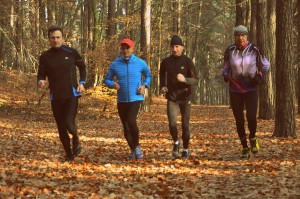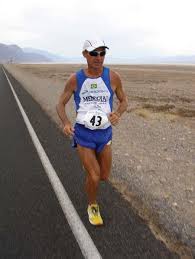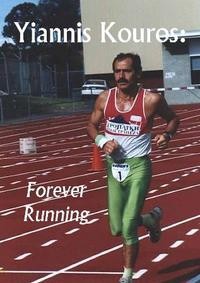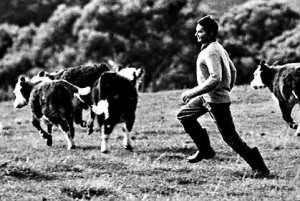English translation of Anna Meysztowicz – below the Polish text
Niektórzy uważają, że ultra są biegami powyżej 42km, inni mówią – 50km to za mało, chyba, że po górach.. jeszcze inni łączą to pojęcie z okrągłą liczbą 100km. Bieg biegowi nie jest równy, teren czy klimat mogą wiele zmienić, więc wydaje mi się, że określenie: „jeśli czujesz ulgę, że zostało tylko 30km to znaczy, że biegniesz w ultra” , dobrze oddaje to pojęcie.

Pamiętam swój pierwszy Maraton, ból i satysfakcję, które na raz smakowałem na mecie. Trzy lata później biegłem 100km po Beskidach – Bieg 7 Dolin – i nie zauważyłem w ogóle 42km. Dopiero na 50km zacząłem się skupiać nad swoimi brakami w przygotowaniu i stanem odwodnienia. Poczytałem trochę o biegach ultra i mam świadomość, że wszystko jest w głowie. Zmęczenie i chęć rezygnacji pojawia się wielokrotnie, tak w czasie przygotowań jak i w czasie samej próby – tu liczę na Waszą pomoc. Co do przygotowania fizycznego, [bieg RZEŹNIKA 77,7km po górach] to będziemy trenowali wg. zmodyfikowanego, mojego starego planu, a po dodatkową pomoc dla Andrzeja udam się do Wojtka Ratkowskiego, którego znacie z 1szej edycji „Ironman za respiratory”. Dla tych, którzy nie znają: prof. dr hab Wojciech Ratkowski, pracuje naukowo na gdańskiej AWF, jest m.in. specjalistą od wytrzymałości organizmu, w latach 80 był jednym z najlepszych maratończyków na świecie, w 84r Mistrzem Polski w maratonie z czasem 2godz 12min. Odbył już z nami kilka wspólnych treningów weekendowych, do których dołączył i Zdzichu Wojtyło, weteran triathlonu. Co z tego wyniknie nie wiem, ale trenujemy razem.

Dzisiejszy wpis ma być o ultra i ultrasach – tam zmierzamy – więc tylko dodam, że z Andrzejem będziemy musieli zrezygnować z kilku atrakcji życia, na 50% do kwietnia i – sorry Andrzej – tak na ‘sztywno’ w ostatnich 2ch miesiącach. Po Ironmanie, jeden z czytelników, z resztą prof. kardiologii, zauważył, że w blogu było za mało technicznych informacji o treningu i poprosił o bardziej szczegółowe. OK – biorę to pod uwagę tylko z zastrzeżeniem, że nie należy tego traktować jak uniwersalne plany treningowe, każdy organizm jest inny. Z pewnością oprócz biegania, zbudowania wytrzymałości i siły będziemy musieli wzmocnić mięśnie brzucha i pleców, bo ‘gdy nóg nie starczy, całe ciało biegnie’, poza tym ‚dobra góra’ powoduje, że wolniej męczą się nogi. Bardzo ważna kwestia to kilometraż na treningach … cóż, w planie mam jeden miesiąc z zasięgiem 320km – to jest średnio 5x w tygodniu po 16km! Ktoś pomyśli, ale kiedy to biegać? Inny doda – zaszkodzi. Jednak gdy kończyliśmy niedawno wspólny bieg z Wojtkiem Ratkowskim dowiedzieliśmy się, że w latach 80 jako czynny zawodnik biegał po 900km miesięcznie i nie był to trening ultrasów. Poza tym te 300km+ to plan a życie samo pokaże.
Ikony Ultrasów ścigają się np. w Dolinie Śmierci przy temperaturze ok. 50stC w ramach BADWATER Ultramatarhon – 135 mil/217 km/ – rekord trasy należy do Brazylijczyka Valmira Nunesa i wynosi 22g 51min.

Spotykają się także w Grecji w ramach Spartathlonu, wyścigu na 246 km (rekord Yiannisa Kourosa 20g25 min.)

Ten wyścig burzy stereotyp historii wydarzenia, które miało miejsce pół wieku przez Chrystusem. Według Horodota, kurier Pheidippides, przed bitwą pod Maratonem, 490 lat BC, został posłany do Sparty po pomoc (ok. 250km). Według starożytnego historyka biegacz dotarł tam na następny dzień. My jednak zapamiętaliśmy drugi jego bieg, gdy posłaniec po wygranej Greków pobiegł z Maratonu do Aten, by ogłosić zwycięstwo, jednocześnie legenda głosi, że padł martwy po przekazaniu wiadomości. Według dzisiejszych historyków dramatycznej końcówki nie było, drugi bieg miały „tylko 42km” a zawodowi biegacze pokonywali regularnie właśnie takie odległości przenosząc wiadomości.
Gdzieś w Australii jest też ‘zabawa’ na 875 km, którą kiedyś wygrał pasterz owiec, biegnąc w kaloszach. Kiedy zdziwieni komentatorzy pytali go na mecie m.in. o to kiedy spał – odpowiedział „.. a to ja nie wiedziałem, że można było po drodze spać”.

Cliff Young wychował się na farmie, gdzie nie było traktora i musiał zganiać owce na piechotę, co zajmowało czasem i 3 doby. Gdy ich pilnował nauczył się półsnu i tak podczas tych wyjątkowych zawodów zamiast przerwy na spanie odpoczywał w biegu. W wieku 61 lat wygrał bieg z Sydney do Melbourne w czasie 5 dni 15g. i 14min. Co ciekawe 10 000$ nagrody rozdał wśród innych uczestników, których uważał za lepszych od siebie biegaczy.
Andrzej nam bliżej do Pheidippides ‘a, bo mniej kilometrów i zamiast rozdawać chcemy zbierać pieniądze, jednak zastanawiam się – może byśmy w lutym, czy w marcu wyjechali ma naukę pasania owiec? / Tomek
ENG: translation Anna Meysztowicz
1. Ultramarathon
Some believe that ultramarathons are those totalling over 42 km, others say that 50 km is not long enough unless it is in the mountains. Others still connect this term with the round number of 100 km. One run is not equal to another, the terrain or climate can change a lot, so it seems to me that the description: “if you feel relieved that there are only 30 km to go, it means you are running an ultra”, is very appropriate
( Photo ) Hi – we are starting a new story
I remember my first ever marathon, the pain and the satisfaction that I simultaneously felt at the finishing line. Three years later I ran 100 km in the Beskidy – The Run of 7 Valleys (Bieg 7 Dolin) – and I didn’t notice the 42 km. It wasn’t until the 50th km that I began to concentrate on my insufficient preparation and state of dehydration. I read a little about ultra runs and I am aware that it is all in our heads. The exhaustion and wish to resign appear often both during preparations as also during the test itself – and here I am counting on your help. As for the physical preparation for the RZEŹNIK (77.7 km run in the mountains), we will train according to a modified version of my former training plan and, for additional help for Andrzej, I will approach Wojtek Ratkowski, who you already know from the first edition “Ironman for Respirators”. For those who don’t know, Professor Wojciech Ratkowski, PhD, is a researcher at the Gdansk University of Physical Education and Sport (AWF). He is, among others, a specialist in physical endurance of the organism; in the 1980s he was one of the world’s best marathon runners, in 1984, Polish Champion in the marathon with a time of 12 h and 12 min. He has already participated in several of our joint training weekends, where we were also joined by Zdzichu Wojtyło, a veteran of the triathlon. I do not know what this will result in but we are training together. Today’s blog entry is supposed to be about ultramarathons – that’s what we are aiming at – so let me just add that, together with Andrzej, we are going to have to give up on some of life’s pleasures by 50% until April and – sorry Andrzej – completely in the last two months.
After Ironman one of my readers, a professor of cardiology in fact, noted that the blog did not feature enough technical information about my training and asked for more detail. OK – I am taking this into account with the reservation that this should not be treated as a universal training plan as each organism is different. Certainly, aside from running, in order to build our strength and stamina, we will need to strengthen our stomach and back muscles because “when the legs have had enough, the whole body runs”, otherwise “a good head” means that our legs don’t tire as quickly. A very important issue is the number of kilometres during training sessions… well, I have a plan to do 320 km in one month – that is an average of 16 km five times per week! Someone may think, how to find the time to run this? Another will add – that’s harmful. However, when we recently finished a run together with Wojtek Ratkowski, we discovered that, in the 1980s, as an active competitor, he would run 900 km per month and that was not ultramarathon training. Besides the 300+ km is just a plan, and we will soon see what the reality is.
Ultramarathon icons race, for example, in the Valley of Death in 50°C temperatures as part of the BADWATER Ultramarathon – 135 miles (217 km) – the record belongs to the Brazilian Valmira Nunes and amounts to 22 h 51 min.
Runners also meet in Greece as part of the Spartathlon, a race of 246 km (record by Yiannis Kouros: 20 h 25 min.).
This race knocks down the stereotyped story of the event, which took place 500 years BC. According to Horodota, the courier Pheidippides, before the Battle of Marathon, 490 years BC, was sent to Sparta for help (approx. 250 km). According to the ancient historian, the runner arrived there the following day. However, we remembered his second run, when the courier, following the win by the Greeks, ran from Marathon to Athens to announce the victory. Simultaneously legend proclaims that he fell dead after delivering the message. According to historians today, the dramatic end did not take place, the second run was “only 42 km” and professional runners regularly covered just such distances to convey messages.
Somewhere in Australia there is also a “play” for 875 km, which was once won by a shepherd running in gum boots. When astonished commentators asked him at the finishing line about when he slept, for example, he answered: “I didn’t know that you were allowed to sleep along the way”.
Cliff Young grew up on a farm with no tractor and had to herd sheep on foot, which would sometimes take three days. He learned the art of somnolence while looking after them and, during this exceptional race, instead of taking a break to sleep, he would rest while running. At age 61 he won a race from Sydney to Melbourne in 5 days 15 h and 14 min. What’s interesting is that he shared the AUD $10,000 prize with his competitors, who he thought were better runners than him.
Andrzej, we are closer to Pheidippides because there are fewer kilometres and, instead of sharing, we want to collect the money, but I am wondering if, in February or March, we shouldn’t head to shepherding training? Tomek
